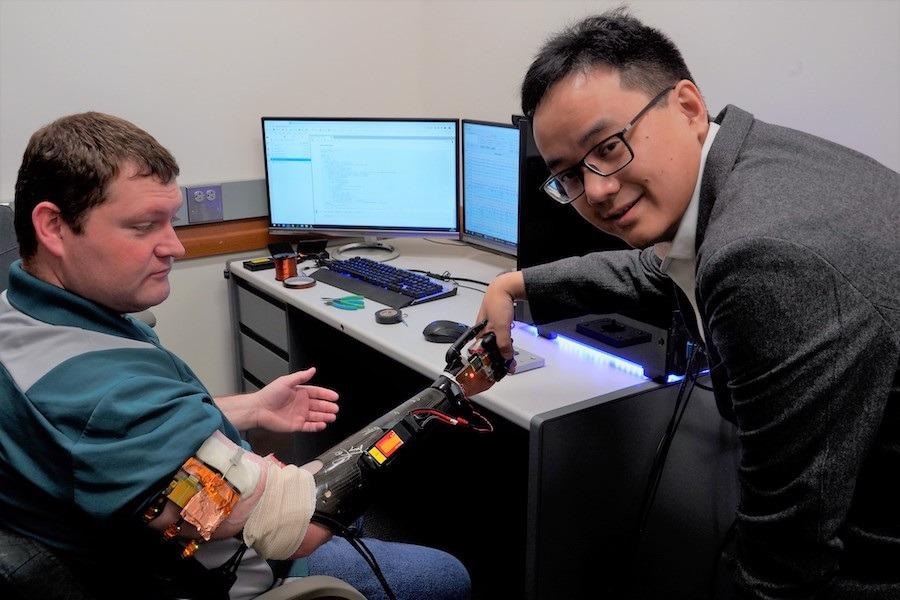
Image credit: Neuroelectronics Lab, University of Minnesota.
A number of existing commercial prosthetic limbs employ a cable and harness system that is regulated by the chest or shoulders, and more sophisticated limbs employ sensors to perceive ultra-fine muscle movements in a patient’s existing limb above the prosthetic. But, both the options can be unintuitive, unwieldy, and require months of practice for amputees to understand how to maneuver them.
Scientists in the Department of Biomedical Engineering at the University, with the help of industry partners, have developed a small, implantable device that fastens to the peripheral nerve in a person’s arm. When integrated with an artificial intelligence (AI) computer and a robotic arm, the device can read and deduce brain signals, enabling upper limb amputees to manipulate the arm using just their thoughts.
The scientists’ latest paper has been published in the Journal of Neural Engineering, a peer-reviewed scientific journal for the interdisciplinary domain of neural engineering.
“It’s a lot more intuitive than any commercial system out there,” said Jules Anh Tuan Nguyen, a postdoctoral researcher and University of Minnesota Twin Cities biomedical engineering Ph.D. graduate.
With other commercial prosthetic systems, when amputees want to move a finger, they don’t actually think about moving a finger. They’re trying to activate the muscles in their arm, since that’s what the system reads. Because of that, these systems require a lot of learning and practice. For our technology, because we interpret the nerve signal directly, it knows the patient’s intention. If they want to move a finger, all they have to do is think about moving that finger.
Jules Anh Tuan Nguyen, Postdoctoral Researcher and Biomedical Engineering PhD Graduate, University of Minnesota Twin Cities
Nguyen has been involved in this research for nearly 10 years with Associate Professor Zhi Yang from the University of Minnesota’s Department of Biomedical Engineering and was one of the main creators of the neural chip platform.
The project commenced in 2012 when Edward Keefer, an industry neuroscientist, and CEO of Nerves, Incorporated, met Yang to discuss developing a nerve implant that could be helpful to amputees. The two innovators received financial support from the U.S. government’s Defense Advanced Research Projects Agency (DARPA) and have since performed quite a few fruitful clinical trials with real amputees.
The scientists also partnered with the University of Minnesota Technology Commercialization office to set up a startup called Fasikl — a play on the term “fascicle” which denotes a bundle of nerve fibers — to market the technology.
“The fact that we can impact real people and one day improve the lives of human patients is really important,” Nguyen said.
It’s fun getting to develop new technologies, but if you’re just doing experiments in a lab, it doesn’t directly impact anyone. That’s why we want to be at the University of Minnesota, involving ourselves in clinical trials. For the past three or four years, I’ve had the privilege of working with several human patients. I can get really emotional when I can help them move their finger or help them do something that they didn’t think was possible before.
Jules Anh Tuan Nguyen, Postdoctoral Researcher and Biomedical Engineering PhD Graduate, University of Minnesota Twin Cities
A huge part of what makes the platform function so well compared to analogous technologies is the integration of AI, which uses machine learning to help deduce the signals from the nerve.
Artificial intelligence has the tremendous capability to help explain a lot of relationships. This technology allows us to record human data, nerve data, accurately. With that kind of nerve data, the AI system can fill in the gaps and determine what’s going on. That’s a really big thing, to be able to combine this new chip technology with AI. It can help answer a lot of questions we couldn’t answer before.
Zhi Yang, Associate Professor, Department of Biomedical Engineering, University of Minnesota Twin Cities
The technology offers benefits not only for amputees but also for other patients who suffer from chronic pain and neurological disorders. Yang predicts a future where invasive brain surgeries may no longer be required and brain signals can be reached via the peripheral nerve instead.
Furthermore, the implantable chip has applications that surpass the field of medicine.
At the moment, the platform requires wires that come via the skin to link to the exterior AI interface and robotic arm. But, if the chip was able to connect remotely to any computer, it would offer humans the chance to use their personal devices — a phone or car, for example — with their brains.
Some of these things are actually happening. A lot of research is moving from what’s in the so-called ‘fantasy’ category into the scientific category. This technology was designed for amputees for sure, but if you talk about its true potential, this could be applicable to all of us.
Zhi Yang, Associate Professor, Department of Biomedical Engineering, University of Minnesota Twin Cities
Besides Yang, Nguyen, and Keefer, other collaborators on this project include Associate Professor Catherine Qi Zhao and researcher Ming Jiang from the University of Minnesota Department of Computer Science and Engineering; Professor Jonathan Cheng from the University of Texas Southwestern Medical Center; and all group members of Yang’s Neuroelectronics Lab in the Department of Biomedical Engineering at the University of Minnesota.
Research Spotlight: UMN technology allows amputees to control a robotic arm with their mind
The University of Minnesota-led team’s technology allows research participant Cameron Slavens to move a robotic arm using only his thoughts. Video Credit: Eve Daniels.
Journal Reference:
Nguyen, A. T., et al. (2022) A portable, self-contained neuroprosthetic hand with deep learning-based finger control. Journal of Neural Engineering. doi.org/10.1088/1741-2552/ac2a8d.